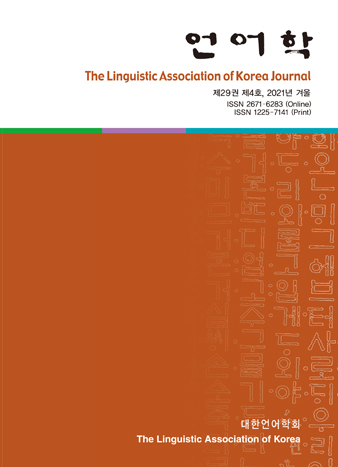대한언어학회 전자저널
29권 4호 (2021년 12월)
- Revisiting Cleft(-like) Constructions in Korean
-
Jung-Min Jo
Pages : 45-64
Abstract
Jo, Jung-Min. (2021). Revisiting cleft(-like) constructions in Korean. The Linguistic Association of Korea Journal, 29(4), 45-64. This paper examines two putative cleft constructions in Korean: Kes-construction and Ki-construction. Since both constructions denote the same truth-conditional meaning along with the similar information structure of topic and focus, it could be conjectured that similar morphosyntactic processes are responsible for deriving the two constructions. Park and Kim (2019) pursued this possibility and claimed that the two constructions are derived from distinct movement processes: Kes-construction from movement to clause-external topic and focus projections, and Ki-construction from movement to clause-internal topic and focus projections. In doing so, they claimed the existence of clause-internal topic and focus projections in Korean, independently of the clause-external topic and focus projections often posited in the analysis of Kes-construction in the literature. This paper closely examines the morphosyntactic and semantic properties of the two constructions and critically reviews Park and Kims claim. Providing a variety of empirical evidence, this paper refutes Park and Kims claim and shows that Ki-construction is not involved with any movement regarding topic and focus information structure and the topic information in Ki-construction is simply base-generated.
Keywords
# Kes-construction # Ki-construction # cleft # topic # focus # information structure # base-generation
References
- Belletti, A. (2001). Inversion as focalization. In A. Hulk & J.-Y. Pollock (Eds.), Subject inversion in Romance and the theory of universal grammar (pp. 60-90). Oxford: Oxford University Press.
- Belletti, A. (2004). Aspects of the low IP area. In L. Rizzi (Ed.), The structure of CP and IP: The cartography of syntactic structures 2. New York: Oxford University Press.
- Cho, S.-Y., & Kim, J.-B. (2002). Echoed verb construction in Korean: A construction-based HPSG analysis. Korean Journal of Linguistics, 27, 661-682.
- Choi, K.-Y. (2000). Korean VP-focus constructions: Another case of base adjunction of X0 to Y0. Studies in Generative Grammar, 10, 329-356.
- Choi, K.-Y. (2001). The echoed verb construction in Korean: Evidence for V-raising. In P. Clancy (Ed.), Japanese/Korean Linguistics, vol. 11. Stanford: CSLI Publication.
- Choi, K.-Y. (2011) Hankwuke kyunyelkwumwunuy kes (Kes in Korean clefts). Studies in Generative Grammar, 21, 21-47.
- Halle, M., & Marantz, A. (1993). Distributed morphology and the pieces of inflection. In S. Keyser & K. Hale (Eds.), The view from building 20. Cambridge, MA: MIT Press.
- Hong, Y.-C. (2015). Kes punyel kwumwunuy chocem yosoey tayhan kice sayngseng pwunsek (A base-generation analysis of the focused phrase in the kes cleft construction). Studies in Generative Grammar, 25, 159-180.
- Jo, J.-M. (2005). Suicing? It’s just one of copular constructions. The Linguistic Association of Korea Journal, 13, 143-167.
- Jo, J.-M. (2013). Predicate contrastive topic constructions: Implications for morpho-syntax in Korean and copy theory of movement. Lingua, 131, 80-111.
- Kang, B. (2006). Some peculiarities of Korean kes cleft constructions. Studia Linguistica, 60, 251-281.
- Kim, J., & Lee, C. (2008). Why multiple clefts are disallowed? In Proceedings of WCCFL 26, 332-339.
- Kim, J.-B., & Sells, P. (2013). Interactions between (pseudo-)clefts and copular constructions in Korean. Linguistic Research, 30, 93-139.
- Kiss, K. (1998). Identification focus versus information focus. Language, 74, 245-273.
- Kiss. K. (1999). The English cleft construction as a focus phrase. In L. Mereu (Ed.), Boundaries of morphology and syntax (pp. 217-229). Amsterdam: John Benjamins Publishing Company.
- Lambrecht, K. (1994). Information and sentence form: topic, focus and the mental representations of discourse referents. New York: Cambridge University Press.
- Lee, C. (1999). Contrastive topic: A locus of the interface. In K. Turner, et al. (Eds.), The semantics/pragmatics interface from different points of view, CRiSPI, vol. 1 (pp. 317-341). London: Elsevier.
- Lee, C. (2000). Contrastive predicates and conventional scales. In A. Okrent & J. Boyle (Eds.), CLS 36-1 (pp. 243-257).
- Lee, C. (2001). Contrastive topic and proposition structure. Paper presented at the Asymmetry Conference, University of Quebec, Montreal.
- Lee, C. (2003). Contrastive topic and/or contrastive focus. In B. McClure (Ed.), Japanese/Korean Linguistics, vol. 12. Stanford: CSLI Publication.
- Lee, C. (2006). Contrastive topic/focus and polarity in discourse. In K. Von Heusinger & K. Turner (Eds.), Where semantics meets pragmatics, CRiSPI, vol. 16 (pp. 381-420). London: Elsevier.
- Lee, C. (2007). Contrastive (predicate) topic, intonation, and scalar meanings. In C. Lee, M. Gordon, & M. Buring (Eds.), Topic and focus: cross-linguistic perspectives on meaning and intonation (pp. 151-175). Dordrecht: Springer.
- Park, M.-K. (2014). Copular and sluicing constructions in Korean, Chinese, and Japanese. Korean Journal of Linguistics, 39, 427-452.
- Park, S.-Y., & Kim, S.-J. (2019). -kinun versus -kesun-clefts and the Korean left periphery. Studies in Generative Grammar, 29(2), 235-258.
- Pierrehumbert, J., & Hirschberg, J. (1990). The meaning of intonational contours in the interpretation of discourse. In P. Cohen, J. Morgan, & M. Pollack (Eds.), Intentions in communication (pp. 271-311). Cambridge, MA: MIT Press.
- Rizzi, L. (1997). The fine structure of the left periphery. In L. Haegeman (Ed.), Elements of grammar (pp. 281-337). Dordrecht: Kluwer Academic Publishers.
- Steedman, M. (1991). Structure and intonation. Language, 67-2, 260-296.
- Yoon, J. H.-S. (1996). Nominal gerund phrases in English as phrasal zero derivations. Linguistics, 34, 329-356.
- Yoon, J. H.-S. (2001). What the Japanese/Korean copula reveals about the interaction of morphology and syntax. In P. Clancy (Ed.), Japanese/Korean Linguistics, vol. 11. Stanford: CSLI Publication.
- Yoon, J. H.-S. (2005). Non-morphological determination of nominal particle ordering in Korean. In L. Heggie & F. Ordonez (Eds.), Clitic and affix combinations: Theoretical perspectives (pp. 239-283). Amsterdam: John Benjamins Publishing Company.
